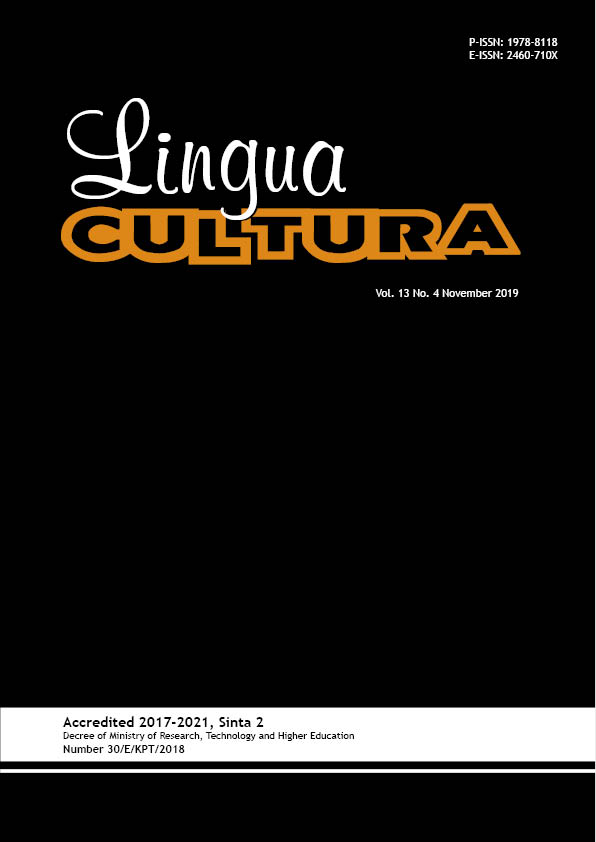The Influence of Social Contexts towards the Identity Development of the Main Character in The Bluest Eye By Toni Morrison
DOI:
https://doi.org/10.21512/lc.v13i4.6138Keywords:
social context, identity confusion, identity developmentAbstract
This research aimed to show how the social contexts influencing the main character of The Bluest Eye, Pecols’s identity development, and the stage of her identity development with the help of Erikson and Marcia’s theories. The research used qualitative research through the literary psychology approach. The data collection had been taken from the novel entitled The Bluest Eye by Toni Morrison, selected and sorted to find out how many among them were supporting the research. The steps were data analysis and data validity. The results show that social contexts greatly affected Pecola’s life, and therefore her identity cannot be developed.; racism, thus, has an influence on all aspects of the black people. Pecola undergoes multiple oppression and abuse as a result of racism, which leads to her self-loathe. She, thus, believes that having blue eyes is the only hope to escape from the suffering she undergoes. It is a warning of identity confusion since she wants to change her identity and becomes white. It pushes her to insanity. Racism and abuse ruin a person’s life by creating hatred and damaged to a person’s soul, and segregate society into groups. It results in the division of groups through the use of terms such as ‘them’ and ‘us’, implying that they are not equal.
References
Afrilyanti., Herlina., Rahmalia, S. (2015). Hubungan pola asuh orangtua dengan status identitas diri remaja. Jurnal Online Mahasiswa, 2(2), 1–9.
Aldridge, J. M., Ala’i, K. G., & Fraser, B. J. (2016). Relationships between school climate and adolescent students’ self-reports of ethnic and moral identity. Learning Environments Research, 19(1), 1–15. https://doi.org/10.1007/s10984-015-9199-9.
Aras, G. (2015). Personality and individual differences: Literature in psychology-psychology in literature. Procedia - Social and Behavioral Sciences, 185, 250–257. https://doi.org/10.1016/j.sbspro.2015.03.452.
Arora, N., & Parkash, V. (2017). Beauty: A tragic reality of racism in Toni Morrison’s â€The Bluest Eyeâ€. International Journal of Advanced Educational Research, 2(5), 147-149.
Beyers, W., & Çok, F. (2008). Adolescent self and identity development in context. Journal of Adolescence, 31(2), 147–150. https://doi.org/10.1016/j.adolescence.2008.03.002.
Brajannoto, D., Rasyid, Y., & Lustyantie, N. (2018). An intuitive logical woman: Personality of main female character in “Arrival†movie by Eric Heisserer. Humaniora, 9(2), 173-185. https://doi.org/10.21512/humaniora.v9i2.4567.
Dalami, E., Suliswati., Farida, P., Rochimah., & Banon, E. (2009). Asuhan keperawatan jiwa dengan masalah psikososial (1st Ed.). Jakarta: Trans Info Media.
DeLara, E. W. (2018). Consequences of childhood bullying on mental health and relationships for young adults. Journal of Child and Family Studies, 28(9), 2379-2389. https://doi.org/10.1007/s10826-018-1197-y.
Emir, B. C. (2016). Literature and psychology in the context of the interaction of social sciences. Khazar Journal of Humanities and Social Sciences, 19(4), 49–55. https://doi.org/10.1890/080130.
Erikson, E. H. (1968). Identity youth and crisis. New York: W.W. Norton & Company, Inc.
Erikson, E. H. (2010). Childhood and society karya monumental tentang hubungan antara masa kanak-kanak dengan psikososial (1st Ed.). Yogyakarta: Pustaka Pelajar.
Haerunisa, D., Taftazani, B. M., & Apsari, N. C. (2015). Pemenuhan kebutuhan dasar anak oleh Panti Sosial Asuhan Anak (PSAA). Prosiding Penelitian dan Pengabdian Kepada Masyarakat, 2(1), 25-30. https://doi.org/10.24198/jppm.v2i1.13232.
James, J., & Rajan, S. K. (2015). Identity crisis among early adolescents in relations to abusive experiences in the childhood, social support, and parental support. Journal of Psychosocial Research, 10(1), 165–173.
Maleki, N., & Haj’jari, M. J. (2016). Negrophobia and anti-negritude in Morrison’s â€The Bluest Eyeâ€. Epiphany, 8(1), 69-81. https://doi.org/10.21533/epiphany.v8i1.120.
Panahi, S. (2015). Role of parents, teachers, and community in adolescents issues. Unique Journal of Pharmaceutical and Biological Sciences, 3(2), 1–11.
Ramdhanu, C. A., Sunarya, Y., & Nurhudaya. (2019). Faktor-faktor yang mempengaruhi identitas diri. Journal of Innovative Counseling: Theory, Practice, & Research, 3(1), 7-17.
Ratner, K. (2014). The role of parenting and attachment in identity style development. The University of Central Florida Undergraduate Research Journal, 7(1), 15–26.
Rijali, A. (2018). Analisis data kualitatif. Jurnal Alhadharah, Ilmu Dakwah, 17(33), 81–95. https://doi.org/10.18592/alhadharah.v17i33.2374.
Santrock, J. W. (2003). Adolescence perkembangan remaja (6th Ed.). Jakarta: Penerbit Erlangga.
Santrock, J. W. (2012). Adolescene (14th Ed.). New York: McGraw-Hill.
Selvam, T. (2018). Functions of peer group in adolescence life. International Journal of Scientific Research and Review, 6(11), 131-135.
Wijaya, I. S. (2016). Konstruksi identitas diri dalam organisasi etnis. Lentera: Jurnal Ilmu Dakwah Dan Komunikasi, 18(2), 31–42. https://doi.org/10.21093/lj.v18i2.762.
Downloads
Published
How to Cite
Issue
Section
License
Authors who publish with this journal agree to the following terms:
a. Authors retain copyright and grant the journal right of first publication with the work simultaneously licensed under a Creative Commons Attribution License - Share Alike that allows others to share the work with an acknowledgment of the work's authorship and initial publication in this journal.
b. Authors are able to enter into separate, additional contractual arrangements for the non-exclusive distribution of the journal's published version of the work (e.g., post it to an institutional repository or publish it in a book), with an acknowledgment of its initial publication in this journal.
c. Authors are permitted and encouraged to post their work online (e.g., in institutional repositories or on their website) prior to and during the submission process, as it can lead to productive exchanges, as well as earlier and greater citation of published work.
USER RIGHTS
All articles published Open Access will be immediately and permanently free for everyone to read and download. We are continuously working with our author communities to select the best choice of license options, currently being defined for this journal as follows: Creative Commons Attribution-Share Alike (CC BY-SA)


















